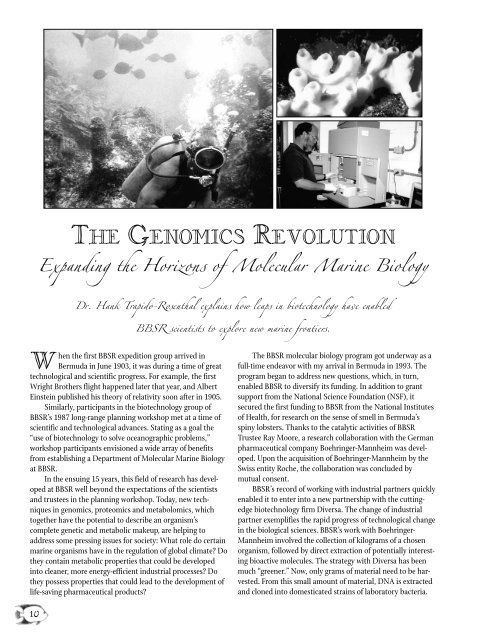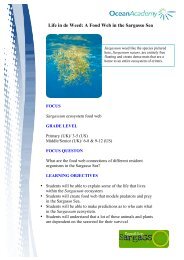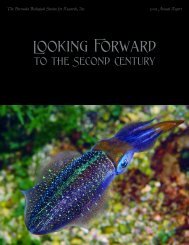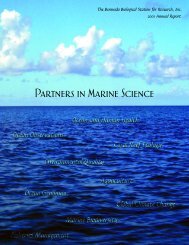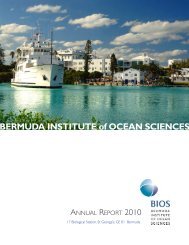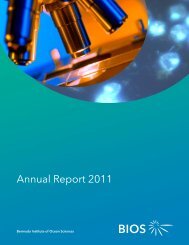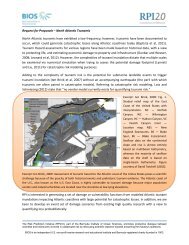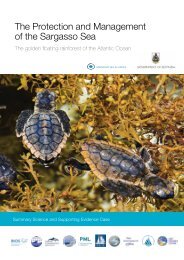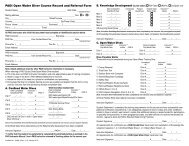When the first <strong>BBSR</strong> expedition group arrived in<strong>Bermuda</strong> in June 1903, it was during a time <strong>of</strong> greattechnological and scientific progress. For example, the firstWright Brothers flight happened later that year, and AlbertEinstein published his theory <strong>of</strong> relativity soon after in 1905.Similarly, participants in the biotechnology group <strong>of</strong><strong>BBSR</strong>’s 1987 long-range planning workshop met at a time <strong>of</strong>scientific and technological advances. Stating as a goal the“use <strong>of</strong> biotechnology to solve oceanographic problems,”workshop participants envisioned a wide array <strong>of</strong> benefitsfrom establishing a Department <strong>of</strong> Molecular Marine Biologyat <strong>BBSR</strong>.In the ensuing 15 years, this field <strong>of</strong> research has developedat <strong>BBSR</strong> well beyond the expectations <strong>of</strong> the scientistsand trustees in the planning workshop. Today, new techniquesin genomics, proteomics and metabolomics, whichtogether have the potential to describe an organism’scomplete genetic and metabolic makeup, are helping toaddress some pressing issues for society: What role do certainmarine organisms have in the regulation <strong>of</strong> global climate? Dothey contain metabolic properties that could be developedinto cleaner, more energy-efficient industrial processes? Dothey possess properties that could lead to the development <strong>of</strong>life-saving pharmaceutical products?10THE GENOMICS REVOLUTIONExpanding the Horizons <strong>of</strong> Molecular Marine BiologyDr. Hank Trapido-Rosenthal explains how leaps in biotechnology have enabled<strong>BBSR</strong> scientists to explore new marine frontiers.The <strong>BBSR</strong> molecular biology program got underway as afull-time endeavor with my arrival in <strong>Bermuda</strong> in 1993. Theprogram began to address new questions, which, in turn,enabled <strong>BBSR</strong> to diversify its funding. In addition to grantsupport from the National Science Foundation (NSF), itsecured the first funding to <strong>BBSR</strong> from the National <strong>Institute</strong>s<strong>of</strong> Health, for research on the sense <strong>of</strong> smell in <strong>Bermuda</strong>’sspiny lobsters. Thanks to the catalytic activities <strong>of</strong> <strong>BBSR</strong>Trustee Ray Moore, a research collaboration with the Germanpharmaceutical company Boehringer-Mannheim was developed.Upon the acquisition <strong>of</strong> Boehringer-Mannheim by theSwiss entity Roche, the collaboration was concluded bymutual consent.<strong>BBSR</strong>’s record <strong>of</strong> working with industrial partners quicklyenabled it to enter into a new partnership with the cuttingedgebiotechnology firm Diversa. The change <strong>of</strong> industrialpartner exemplifies the rapid progress <strong>of</strong> technological changein the biological sciences. <strong>BBSR</strong>’s work with Boehringer-Mannheim involved the collection <strong>of</strong> kilograms <strong>of</strong> a chosenorganism, followed by direct extraction <strong>of</strong> potentially interestingbioactive molecules. The strategy with Diversa has beenmuch “greener.” Now, only grams <strong>of</strong> material need to be harvested.From this small amount <strong>of</strong> material, DNA is extractedand cloned into domesticated strains <strong>of</strong> laboratory bacteria.
The resulting libraries <strong>of</strong> bacterial clones are then screened t<strong>of</strong>ind the individual clones containing the genes that code forthe construction <strong>of</strong> the desired bioactive molecules, whichmay have important pharmaceutical or other applications.The molecular biology program has established closesynergistic relationships with other <strong>BBSR</strong> programs as well.The <strong>Ocean</strong>ic Microbial Observatory, developed at <strong>BBSR</strong> byDrs. Stephen Giovannoni <strong>of</strong> Oregon State University andCraig Carlson, now at the University <strong>of</strong> California, SantaBarbara, applies the tools <strong>of</strong> molecular biology to the study <strong>of</strong>microbial populations in the Sargasso Sea. The microbialobservatory has taken advantage <strong>of</strong>, and contributed to, themolecular biology instrumentation infrastructure at <strong>BBSR</strong>.For example, in 1997 <strong>BBSR</strong> acquired a state-<strong>of</strong>-the-art videomicroscope, which allows technicians to catalogue in secondsbacteria or other marine organisms that used to take weeks ormonths to study.Similarly, I am working closely with <strong>BBSR</strong>’s marine ecotoxicologyprogram, run by Dr. Richard Owen, to use the tools <strong>of</strong>genomics, proteomics and metabolomicsto develop diagnostic testsdesigned to monitor the health <strong>of</strong> keycomponents <strong>of</strong> coral reef ecosystems.The molecular biology programwas a key factor in the establishment<strong>of</strong> <strong>BBSR</strong>’s International Center for<strong>Ocean</strong> and Human Health in 1998.This research center is considered tobe one <strong>of</strong> the first to address oceanhealth/human health connections onan international scale.In addition, <strong>BBSR</strong>’s new molecularbiology capabilities have brought anew educational dimension to theinstitution over the past decade. Twosummer courses were developed that took advantage <strong>of</strong> thesecapabilities: Molecular Ecology and Physiology <strong>of</strong> MarineSymbioses, and Chemosensory Neurobiology in the MarineEnvironment. These continue to be popular <strong>of</strong>ferings in<strong>BBSR</strong>’s summer sessions. The opportunities to apply the techniques<strong>of</strong> molecular biology to questions concerning themarine environment drew an increasing number <strong>of</strong> applicantsto the annual NSF-funded Research Experience forUndergraduates semester at <strong>BBSR</strong>. A considerable number <strong>of</strong>these alumni have gone on to their graduate and pr<strong>of</strong>essionalcareers with a molecular approach to marine biology thatbegan at <strong>BBSR</strong>.Seminar courses on the application <strong>of</strong> molecular tools tomarine questions were also added to the curricula <strong>of</strong> <strong>BBSR</strong>’sDuke University and University <strong>of</strong> Rhode Island-RogerWilliams undergraduate spring and fall semester programs.The new Marine Genome Bankdata set may become as significantover time to the world <strong>of</strong> scienceas <strong>BBSR</strong>’s Hydrostation “S”time-series measurements,begun in 1954.At the graduate level, a long line <strong>of</strong> talented and motivatedstudents have conducted master’s and doctoral research in<strong>BBSR</strong>’s molecular biology laboratories. These students haveapplied molecular techniques to a number <strong>of</strong> topics, rangingfrom mangrove ecosystems to molecular taxonomy to themolecular physiology <strong>of</strong> symbiotic relationships that are thefoundation <strong>of</strong> <strong>Bermuda</strong>’s coral reef ecosystems. Their worknow comprises a significant contribution to pr<strong>of</strong>essionalmarine biology literature, and the students themselves havegone on to research, teaching and policy-making careers.From both a research and an educational perspective,<strong>2002</strong> was clearly the most fruitful year to date for <strong>BBSR</strong>’smolecular biology program. The skills and resources <strong>of</strong> theprogram were combined with those <strong>of</strong> the <strong>Ocean</strong>ic MicrobialObservatory to develop <strong>BBSR</strong>’s Marine Genome Bank.Libraries <strong>of</strong> environmental DNA, taken from blue-water environmentssuch as the Sargasso Sea and inshore environmentssuch as Harrington Sound and various coral reef settings, arebeing built and stored at <strong>BBSR</strong>. This bank <strong>of</strong> environmentalgenomic material will be available forthe research endeavors <strong>of</strong> bothresident and visiting, and academicand industrial, scientists seeking abetter understanding <strong>of</strong> how biologyworks in marine ecosystems and howthis biology can be harnessed for thebenefit <strong>of</strong> society.Arguably, this new data set,begun in <strong>2002</strong> from <strong>Bermuda</strong>’s idealmid-ocean location, may become assignificant over time to the world <strong>of</strong>science as <strong>BBSR</strong>’s Hydrostation “S”time-series measurements, begun in1954.Another exciting development at<strong>BBSR</strong> during <strong>2002</strong> was the addition <strong>of</strong> genomics pioneer Dr.Craig Venter to the Board <strong>of</strong> Trustees. His standing-room-onlypublic lecture in <strong>BBSR</strong>’s Hanson Hall in May <strong>2002</strong> broughtincreased attention to the unique opportunities that<strong>Bermuda</strong>’s location and <strong>BBSR</strong>’s genomics program provide tothe world <strong>of</strong> science. By year-end, <strong>BBSR</strong> had begun a researchcollaboration with Venter, Nobel Laureate Hamilton Smithand their colleagues, which we believe will bear fruit in yearsto come.In the short period <strong>of</strong> time that it has been in existence,the molecular biology program at <strong>BBSR</strong> has participated inone <strong>of</strong> the most pr<strong>of</strong>ound technological revolutions inmodern science. It’s safe to say that the vision <strong>of</strong> that 1987planning workshop has more than been fulfilled. At the sametime, the opportunities presented by the current period <strong>of</strong>rapid technological and scientific advances are even greater.Left: A diver collects samples from <strong>Bermuda</strong>’s coral reefs during the 1960sUpper right: Now only small amounts <strong>of</strong> material from marine sponges are needed for DNA cloning in the molecular biology laboratoryLower right: Associate Research Scientist Dr. Hank Trapido-Rosenthal loads <strong>BBSR</strong>’s new ABI 310 robotic DNA sequencer11


